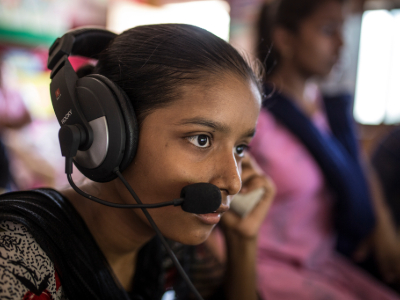Cover image: ©UNICEF/UN0210155
Children, or everyone under the age of 18, make up an estimated one in three internet users globally. The digital world provides children with unprecedented opportunities, while also exposing them to online risks and potential harms that require dedicated efforts to understand and address.
Governments, parents and caregivers, educators, civil society, and children and young people themselves all around the world have a role to play in shaping a safe and positive digital environment for children. As the providers of digital products and services, the actions of businesses are also a critical component of these efforts. Every business has the responsibility to respect children’s rights in the digital environment and can seize opportunities to support child rights and well-being through their products and services.
This e-learning package for industry, developed by ITU and UNICEF, includes four modules spanning foundational child rights and business issues and knowledge on the digital environment. If your company develops or deploys digital technologies, these modules will support you to better understand how child rights intersect with your company’s responsibilities, potential risks and harms for children to think about in your daily operations, and ideas of where to go next on your child rights journey.
We warmly invite you to use these modules to support your and colleagues’ understanding of child rights issues, and to build confidence to engage in targeting problems and developing solutions with your peers and other relevant stakeholders. Happy learning!
Learning objectives
At the end of this course, you will be able to:
- Describe the core frameworks underpinning child rights and responsible business conduct
- Understand the types of online risks and potential harms that children can encounter in the digital environment
- Explain the issue of online child sexual exploitation and abuse and how it relates to digital business products and services
- Identify opportunities to positively support children’s rights and well-being through business plans, strategies and actions
- Start identifying actions that your business can take to better integrate child rights across digital policies and practices.
Audience
Length
It should take you about 2 hours to complete this self-paced course.
Methodology
This course is composed of four self-paced modules, each of which introduces key concepts and definitions with examples and case studies where possible. A quiz appears at the end of every module to test understanding of the content presented.
Structure
This course is composed of 4 modules:
- Understanding children’s rights in the digital environment: Core frameworks and implications for business
- Respecting children’s rights: Understanding and addressing online risks and harms
- Deep-dive: Online child sexual exploitation and abuse
- Supporting children’s rights and well-being in the digital age
Contact details
Content issues and questions:
Josianne Galea Baron (jgaleabaron@unicef.org)
Afrooz Kaviani Johnson (akavianijohnson@unicef.org)
